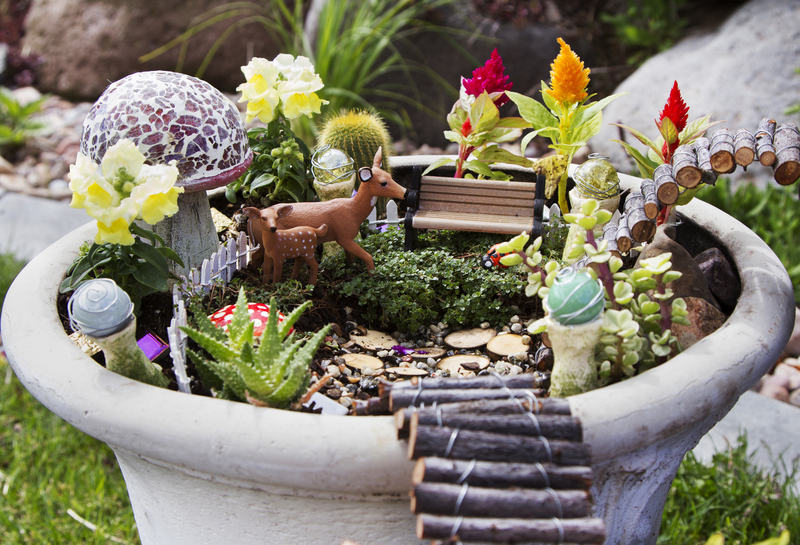Garden stability: Solutions for wind interference
Posted on 30/06/2025
Garden Stability: Solutions for Wind Interference
Have you ever noticed your plants struggle to survive after a stormy day? Gardeners everywhere face challenges when strong winds threaten the stability and beauty of their outdoor spaces. Garden stability against wind interference isn't just about saving your flowers--it's about building a resilient ecosystem that thrives even in adverse weather. In this comprehensive, SEO-optimized article, we'll explore strategies, solutions, and expert tips to protect your garden from wind damage, ensuring that your landscaping efforts yield long-lasting results.

Understanding Wind Interference and Its Impact on Gardens
What is Wind Interference?
Wind interference refers to the disruptive effect of strong, gusty winds on your garden. Wind can dry out foliage, cause soil erosion, snap stems, uproot young plants, and create an overall hostile microclimate for your beloved vegetation. Addressing garden stability in windy areas begins with understanding how and why wind behaves the way it does around your property.
How Does Wind Affect Your Garden?
- Physical Damage: Winds can break branches, uproot plants, and knock over structures such as trellises or decorative elements.
- Desiccation: Wind accelerates water evaporation from both soil and plant leaves, leaving plants dehydrated.
- Soil Erosion: Gusts may blow away topsoil or organic matter, reducing soil fertility and root stability.
- Pollination Disruption: Excessive wind can interfere with pollinator activity and disrupt essential plant reproduction processes.
Assessing Your Garden's Vulnerability to Wind
Before implementing wind protection solutions for your garden, conduct a thorough assessment of your garden's landscape. Observe prevailing wind directions, identify vulnerable spots, and take note of any existing damage or areas where plants consistently appear stressed.
Key Factors to Consider
- Site Topography: Gardens situated on exposed hills or open spaces are typically more prone to wind damage.
- Building Placement: Structures can direct wind into concentrated flows, intensifying wind pressure in certain areas.
- Existing Plant Cover: Dense plantings or mature trees already provide some windbreak, but isolated beds may need extra support.
Proven Wind Protection Strategies for Garden Stability
1. Installing Windbreaks
Windbreaks are one of the most effective solutions for stabilizing your garden against wind. These barriers reduce wind speed and protect sensitive plants.
- Living Windbreaks: Strategically plant dense, tall shrubs, evergreen trees, or hedges on the windward side of your garden. Species such as Arborvitae, Juniper, or Holly make excellent choices.
- Artificial Windbreaks: Use fences, trellises, or windbreak fabric to deflect and disrupt winds. Opt for permeable materials; solid barriers may create turbulent zones behind them.
TIP: For best results, windbreaks should be at least 50% permeable to allow some wind through and avoid creating damaging eddies on the leeward side.
2. Creating Wind-Sheltered Microclimates
Garden stability in windy conditions often involves creating microclimates--small, sheltered areas within your garden that are less exposed to the harshest winds.
- Use walls, sheds, or garden structures in combination with plantings to create nooks and alcoves.
- Plan taller plantings or structures on the windward side, gradually decreasing height towards the leeward side for a layered effect.
3. Choosing Wind-Tolerant Plants
Some plants are naturally more resilient to wind. Incorporating these into your wind-resistant garden design adds another layer of defense:
- Flexible Stems and Low Growth: Plants such as ornamental grasses, junipers, and lavender are well-suited.
- Deep Root Systems: Perennials like Rudbeckia and Coreopsis can anchor themselves even during strong gusts.
- Native Species: Local flora are often better adapted to prevailing weather conditions and provide additional ecosystem support.
4. Staking and Supporting Delicate Plants
Younger trees, tall flowers, and vines may need extra support, particularly in their formative years. Use stakes, guy wires, or plant cages to secure plants in the wind.
- Use soft, flexible materials for tying, such as cloth or special garden ties, to avoid damaging stems.
- Check supports regularly and adjust as the plant grows to prevent girdling or constriction.
5. Mulching and Ground Cover for Soil Stability
One underestimated aspect of wind-proofing your garden is protecting the soil. Mulching helps anchor soil particles, prevents erosion, and retains moisture even on blustery days.
- Organic mulches: Bark chips, straw, or composted leaves provide a natural, eco-friendly barrier against wind erosion.
- Living mulches: Ground covers like creeping thyme, clover, or vinca minor form dense mats, binding the soil and reducing splash erosion during rainstorms.
6. Smart Plant Arrangement and Spacing
Plant spacing plays a critical role in wind defense. Crowded beds can provide mutual support, with stems buffering wind for neighboring plants. On the other hand, wide open beds leave individual plants more exposed.
- Cluster fragile plants behind hardier, robust species.
- Arrange beds perpendicular to prevailing winds to minimize exposure.
Innovative Solutions for Maximizing Garden Stability in Windy Conditions
7. Modern Wind Protection Products
The gardening market now features innovative products designed for wind interference solutions:
- Windbreak Netting: Durable, UV-resistant mesh products that soften the force of the wind while allowing sufficient air flow for plant health.
- Anchor Systems: Heavy-duty anchors or spikes can secure raised beds, small greenhouses, and vertical gardens against wind uplift.
- Row Covers: Floating row covers can shield delicate seedlings and vegetables from gusty conditions while promoting healthy growth.
8. Utilizing Raised Beds and Wind-Resilient Containers
Raised beds or heavy, weighted containers are less likely to tip or suffer from root exposure during windy spells. Use sturdy, broad-based planters and avoid top-heavy containers in exposed sites.
9. Designing for Wind Flow
Consider the way wind flows across your property and design your garden to redirect or diffuse it:
- Baffle Effect: Angle fences and windbreaks to gently funnel wind away from sensitive planting areas.
- Curved Barriers: Curved or staggered fences, rather than straight lines, reduce wind speed more effectively and minimize damage-causing turbulence.
Long-Term Maintenance for Garden Wind Stability
Regular Garden Inspections
An ounce of prevention is truly worth a pound of cure. Walk your garden after high winds to check for:
- Loose or damaged plant ties and stakes
- Broken branches or leaning trees
- Displaced mulch or soil erosion
Training and Pruning Practices
Regular pruning contributes to wind-stable garden design. Remove weak, crossing branches and shape plants to reduce wind resistance. For trees, encourage a strong, central leader and sturdy side branches to minimize the risk of breakage.
Gradual Adaptation
Gardeners can toughen young plants by exposing them to mild winds during the growing season. This "hardening off" process helps develop stronger stems and roots, resulting in better long-term resilience in the face of wind interference.
Bonus Tips: Sustainable Approaches for Wind-Resistant Gardens
Incorporate Biodiversity
Mixing plant types, heights, and textures makes your garden more visually appealing and better equipped to withstand wind. Biodiverse gardens tend to be more self-sustaining, with multiple elements working together to offset weather extremes.
Emphasize Soil Health
Healthy, well-structured soil anchors plant roots and provides resilience during extreme weather. Regular composting, green manure, and minimal disturbance are part of a holistic solution to garden stability problems caused by wind.
Partner with Neighbors
Collaborating with adjacent property owners to create larger-scale windbreaks can benefit entire the community. A shared hedge or shelterbelt can significantly improve garden wind protection for multiple gardens.
Common Mistakes to Avoid When Addressing Wind Interference
- Using Solid Barriers: Completely solid fences or walls often cause more turbulence than they prevent. Go for semi-permeable solutions instead.
- Ignoring Prevailing Wind Direction: Study local wind patterns before planting or erecting windbreaks for optimal efficiency.
- Neglecting Plant Care: Forgetting to check and adjust plant supports or ignoring signs of wind stress can lead to bigger problems down the line.
- Planting Large Trees Too Close Together: Crowding can increase the risk of uprooting during storms as tree canopies become entangled.

Conclusion: Building Wind-Stable, Resilient Gardens
Ensuring garden stability in windy locations is a multi-faceted process that combines smart planning, careful plant selection, structural interventions, and regular maintenance. By rotating your strategy between natural windbreaks, innovative products, thoughtful arrangement, and ongoing care, you'll create a vibrant, flourishing garden that's ready to face even the stiffest breezes.
Remember, a wind-proof garden isn't just about protecting what you've planted--it's about fostering an environment that encourages healthy growth, biodiversity, and beauty, no matter what the weather brings. Whether you're a beginner or a seasoned gardener, applying these solutions for wind interference will ensure your garden landscape remains stunning and stable for years to come.
Frequently Asked Questions: Garden Stability and Wind Interference
Q: What is the best type of windbreak for a small garden?
A: In small spaces, a combination of evergreen hedges and permeable fencing (like slatted wood or mesh) is ideal. This lets air flow through while significantly reducing wind speed.
Q: How close should I plant my windbreak shrubs?
A: For optimal density, plant windbreak shrubs at half their mature width apart. For example, if the selected shrub grows to 4 feet wide, plant them 2 feet apart.
Q: Can I use temporary wind protection?
A: Absolutely! Row covers, pop-up mesh screens, or even a few garden chairs strategically placed can offer temporary shelter during strong wind events.
Q: Does mulching really help with wind stability?
A: Yes. Mulching not only reduces water loss and temperature fluctuation--crucial in windy areas--but also weighs down the soil and protects vulnerable seeds and roots.
Implement these wind interference solutions for garden stability and watch your outdoor oasis endure and flourish, transforming windy woes into sustainable, beautiful green spaces for all to enjoy.

